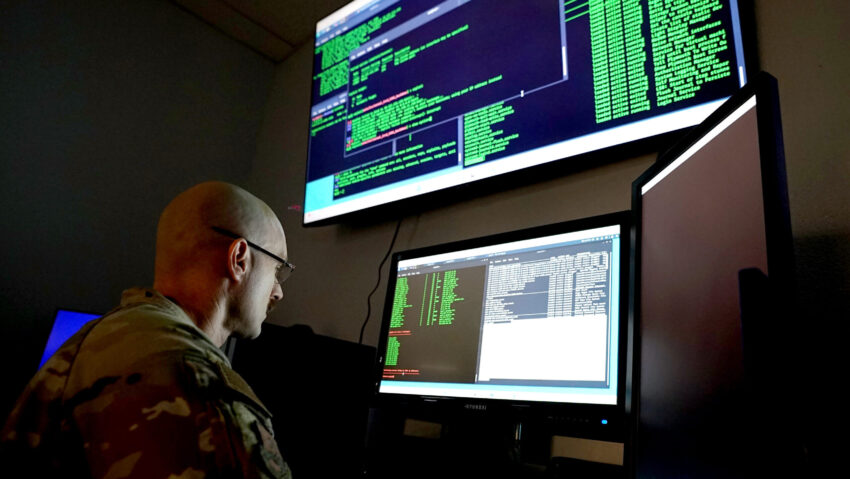An 149th Intelligence Squadron airman conducts training in a computer training lab at Mather Field, California Dec. 2, 2023. The December 2023 UTA focus was on the readiness of the airmen by embracing their unit’s stated mission to “Organize, train, and equip Cyber-ISR leaders to provide intelligence in support of federal and state mission priorities.
WASHINGTON — “The United States is in a race to achieve global dominance in artificial intelligence,” begins the introduction to America’s AI Action Plan, released this morning by the White House. The prime adversary in that race, other passages make clear, is China.
Overall, the Action Plan unambiguously frames AI as a winner-take-all competition between great powers.
“Whoever has the largest AI ecosystem will set global AI standards and reap broad economic and military benefits,” the introduction continues. “Just like we won the space race, it is imperative that the United States and its allies win this race.”
While most of the specific items in the Action Plan relate to domestic R&D, the economy, or international trade, it also includes a long to-do list for the Department of Defense. Of about 19 “recommended policy actions” explicitly citing DoD (the “Action Plan” is not an Executive Order and only “recommends” actions rather than directing them), five relate to the Department’s own internal workings. The others all give the Pentagon a prominent or even leading role in setting standards and coordinating efforts across the executive branch.
Particularly interesting is a call for DARPA, the Pentagon’s dedicated unit for high-risk, high-payoff R&D, to lead an interagency “technology development program” to address a fundamental problem with cutting-edge AI: Even the people who build it don’t really know how it works.
That’s particularly true for generative AIs such as Large Language Models, which can summarize masses of data and even generate surprising insights but also frequently “hallucinate” and output falsehoods in unpredictable ways.
“Technologists know how LLMs work at a high level, but often cannot explain why a model produced a specific output,” the Action Plan notes. “This lack of predictability … can make it challenging to use advanced AI in defense, national security, or other applications where lives are at stake.” (Arguably, it makes GenAI a tricky tool to trust even when the stakes are lower, as a recent Marine Corps field manual warns).
In addition to the DARPA-led program, this basket of actions — under the heading “AI Interpretability, Control, & Robustness” — also asks DoD to coordinate with Energy, Commerce, Homeland Security, and other agencies on “AI Hackathons,” basically open invitations to outside experts to stage (non-destructive) attacks on their systems and report what they find. The Defense Department began embracing this approach with its “Hack the Pentagon” competition back in the last year of the Obama administration.
Another Pentagon initiative promoted in today’s Trump plan embraces a Biden-era catchphrase, “Responsible AI.” It was one of Trump’s previous Secretaries of Defense, Mark Esper, who officially directed DoD to follow a set list of ethical principles, but it was under Biden that Pentagon officials built on those broad strokes and created highly specific interactive online checklists for officials running AI programs.
And while Trump annulled many of Biden’s AI directives within weeks of taking office in January, the “RAI” initiative has not only survived but apparently won White House approval. Federal agencies, “led by DoD,” should “continue to refine DOD’s Responsible AI and Generative AI Frameworks, Roadmaps, and Toolkits,” the AI Action Plan recommends.
The Action Plan also gives DoD a leading or prominent role in multiple AI security initiatives. DoD should lead interagency efforts to “create new technical standards for high-security AI centers” and to assess adversary progress in AI.
DoD should support the Office of the Director of National Intelligence in creating a “Standard on AI Assurance” for the Intelligence Community, most of whose personnel work at DoD. And it should work with other agencies on a host of issues, from stimulating domestic high-tech manufacturing to improving export controls.
As for the five recommendations about upgrading DoD itself, perhaps the most intriguing — albeit vague — recommendation calls for “establish[ing] an AI & Autonomous Systems Virtual Proving Ground.
It’s unclear even whether this is to be a real-world test facility or some kind of Matrix-style super-simulation: The word “virtual” in the name implies it’s all online, while the call to assess “geographic … requirements necessary for such a facility” suggests there might be a physical site. The White House did not immediately respond to a request for clarification.
The DoD is also tasked to make its war colleges “hubs of AI research,” to upskill its workforce, and identify “workflows” — a term used for both bureaucratic processes and military war planning — that can be automated with AI. Perhaps most somberly, the Action Plan also wants DoD to get priority access with cloud providers and other computing services so it can continue to use them in wartime.
Click this link for the original source of this article.
Author: Sydney J. Freedberg Jr.
This content is courtesy of, and owned and copyrighted by, https://breakingdefense.com and its author. This content is made available by use of the public RSS feed offered by the host site and is used for educational purposes only. If you are the author or represent the host site and would like this content removed now and in the future, please contact USSANews.com using the email address in the Contact page found in the website menu.








